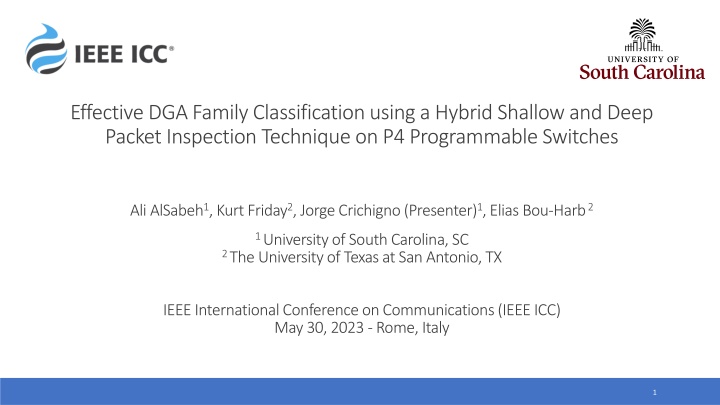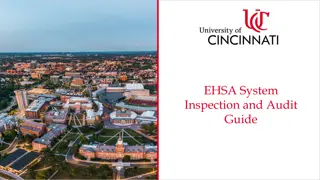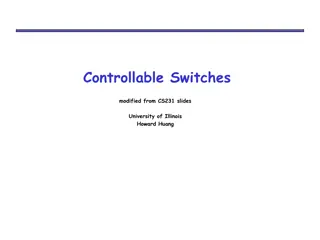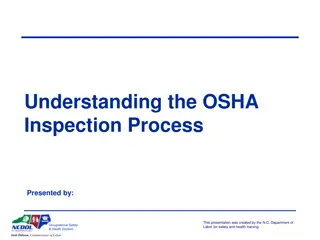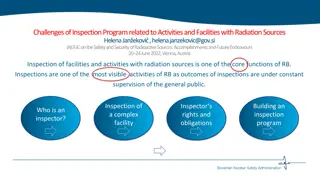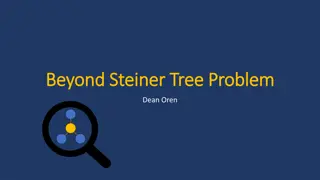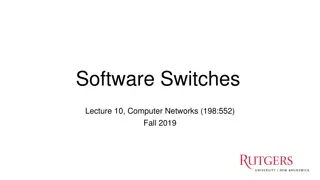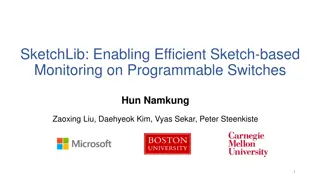Effective DGA Family Classification using Hybrid Inspection Technique on P4 Switches
Attackers utilize Domain Generation Algorithms (DGAs) as dynamic communication methods in malware like botnets and ransomware to evade firewall controls. This study presents a novel approach that combines shallow and deep packet inspection on P4 Programmable Switches for efficient classification of DGA families, aiding in identifying malware types such as Trojans and Backdoors.
Download Presentation

Please find below an Image/Link to download the presentation.
The content on the website is provided AS IS for your information and personal use only. It may not be sold, licensed, or shared on other websites without obtaining consent from the author.If you encounter any issues during the download, it is possible that the publisher has removed the file from their server.
You are allowed to download the files provided on this website for personal or commercial use, subject to the condition that they are used lawfully. All files are the property of their respective owners.
The content on the website is provided AS IS for your information and personal use only. It may not be sold, licensed, or shared on other websites without obtaining consent from the author.
E N D
Presentation Transcript
Effective DGA Family Classification using a Hybrid Shallow and Deep Packet Inspection Technique on P4 Programmable Switches Ali AlSabeh1, Kurt Friday2, Jorge Crichigno (Presenter)1, Elias Bou-Harb 2 1 University of South Carolina, SC 2 The University of Texas at San Antonio, TX IEEE International Conference on Communications (IEEE ICC) May 30, 2023 - Rome, Italy 1
Introduction Attackers often use a Command and Control (C2) server to establish communication between infected host/s and bot master Domain Generation Algorithms (DGAs) are the de facto dynamic C2 communication method used by malware, including botnets, ransomware, and many others1 1 Dynamic Resolution: Domain Generation Algorithms. [Online]. Available: https://tinyurl.com/44hz9hpm. 2 Effective DGA Family Classification using a Hybrid Shallow and Deep Packet Inspection Technique on P4 Programmable Switches
DGA Attacks DGAs evade firewall controls by frequently changing the domain name selected from a large pool of candidates DNS resolver Malware infected host 1 The malware makes DNS queries to resolve the IP addresses of these generated domains ... network ... C2 server Only a few of these queries will be successful; most of them will result in Non-Existent Domain (NXD) responses 2 3 DNS reply w/ C2 IP address DNS query DNS NXD reply (1) DNS queries. (2) (NXD) replies. (3) Eventually, a query for the actual domain is sent and malware-C2 communication starts. 3 Effective DGA Family Classification using a Hybrid Shallow and Deep Packet Inspection Technique on P4 Programmable Switches
DGA Attacks DGAs evade firewall controls by frequently changing the domain name selected from a large pool of candidates b k n l l s n b f z q r . n e t c d z o g o e xi s . t v hdozpcy . com Random domains The malware makes DNS queries to resolve the IP addresses of these generated domains s a l t amountp a t t e r n . com companydepend . com hdozpcy . com Only a few of these queries will be successful; most of them will result in Non-Existent Domain (NXD) responses Genuine English words g e t a d o b e f l a s h p l a y e r . n e t e g t a d o b e f l a s h p l a y e r . n e t e t a d o b g e f l a s h p l a y e r . n e t Permutation of English words DGA-based malware Open DNS resolvers 4 Effective DGA Family Classification using a Hybrid Shallow and Deep Packet Inspection Technique on P4 Programmable Switches
Existing Mitigation Strategies Approaches rely on contextual network traffic analysis (context-aware) or domain name analysis, without considering network traffic (context-less) Most research efforts focus on DGA detection, i.e., they perform binary classification in order to segregate DGAs from benign traffic In addition to DGA detection, it is helpful to classify DGA malware based on the family (Trojan, Backdoor, etc.) 5 Effective DGA Family Classification using a Hybrid Shallow and Deep Packet Inspection Technique on P4 Programmable Switches
Motivation Context-aware approaches analyze the network traffic behavior to fingerprint DGAs Slow since they typically analyze batches of traffic offline Domain-name (context-less) approaches obtain high accuracy with ML models The use of a general-purpose CPU/GPU may create a bottleneck due to high traffic volume There is a need for a system that uses both context-aware and context-less features to classify DGAs 6 Effective DGA Family Classification using a Hybrid Shallow and Deep Packet Inspection Technique on P4 Programmable Switches
Contribution Proposing a novel P4 scheme that uses a hybrid context-aware and context-less feature extraction technique entirely in the data plane Implementing Deep Packet Inspection (DPI) on Intel s Tofino ASIC that extracts and analyzes domain names within 3 microseconds Evaluating the proposed approach on 50 DGA families collected by crawling GBs of malware samples Highlighting the effectiveness of the proposed work in terms of accuracy, performance 7 Effective DGA Family Classification using a Hybrid Shallow and Deep Packet Inspection Technique on P4 Programmable Switches
Overview P4 Switches P4 switches permit the programmer to program the data plane Customized packet processing High granularity in measurements Per-packet traffic analysis and inspection Stateful memory processing Programmable chip P4 code 8 Effective DGA Family Classification using a Hybrid Shallow and Deep Packet Inspection Technique on P4 Programmable Switches
Overview P4 Switches P4 switches permit the programmer to program the data plane Customized packet processing High granularity in measurements Per-packet traffic analysis and inspection Stateful memory processing If the P4 program compiles, it runs on the chip at line rate Reproduced from N. McKeown. Creating an End-to-End Programming Model for Packet Forwarding. Available: https://www.youtube.com/watch?v=fiBuao6YZl0&t=4216s 9 Effective DGA Family Classification using a Hybrid Shallow and Deep Packet Inspection Technique on P4 Programmable Switches
Proposed System The P4 PDP switch collects and stores the context-aware features of the hosts When an NXD response is received, the switch performs DPI on the domain name to extract domain features The switch sends the collected features to the control plane The control plane runs the intelligence to classify the DGA family and initiate the appropriate incidence response 10 Effective DGA Family Classification using a Hybrid Shallow and Deep Packet Inspection Technique on P4 Programmable Switches
Proposed System Context-aware features For each host in the network, the following features are stored in the data plane: Number of IP addresses contacted Inter-arrival Time (IAT) between such IP packets Number of DNS requests made Time it takes for the first NXD response to arrive IAT between subsequent NXD responses Collected in the data plane 11 Effective DGA Family Classification using a Hybrid Shallow and Deep Packet Inspection Technique on P4 Programmable Switches
Proposed System Context-less features It computes the bigram of the domain name; a bigram model may suffice to predict whether a domain name is a legitimate human readable domain ??? Where is the frequency of the bigram b in the subdomain s The frequency value of a bigram b is pre-computed and stored in a Match-Action Table (MAT) The lower the score, the more random the domain name Example: the bigrams of google are: $g , go , oo , og , gl , le , e$ 12 Effective DGA Family Classification using a Hybrid Shallow and Deep Packet Inspection Technique on P4 Programmable Switches
Evaluation Dataset Hundreds of GB of malware samples; 1,311 samples containing 50 DGA families To collect DGA-based malware, only samples that receive NXD responses containing domain names generated by DGAs (based on DGArchive1) are considered Experimental setup The collected dataset was used to train ML models offline on a general-purpose CPU 80% of data was used for training and 20% for testing 1 D. P LOHMANN, DGArchive. [Online]. Available: https://tinyurl. com/yc6whwrc. 13 Effective DGA Family Classification using a Hybrid Shallow and Deep Packet Inspection Technique on P4 Programmable Switches
Evaluation Accuracy (Acc), F1 score, and Precision (Prec) of different ML classifiers during the first 8 NXD responses received were reported The Random Forest (RF) model performed best The Accuracy (Acc) starts at 92% from the first NXD response received and reaches 98% by the 8th NXD response RF: Random Forest; SVM: Support Vector Machine; MLP: Multilayer perceptron; LR: Logistic Regression; GNB: Gaussian Naive Bayes 14 Effective DGA Family Classification using a Hybrid Shallow and Deep Packet Inspection Technique on P4 Programmable Switches
Evaluation Feature extraction time of the proposed approach and EXPLAIN EXPLAIN s available source code was tested on a general-purposed CPU with 64 GB RAM, 2.9 GHz processor with 8 cores 15 Effective DGA Family Classification using a Hybrid Shallow and Deep Packet Inspection Technique on P4 Programmable Switches
Conclusion and Discussion In this work, we propose a hybrid feature extraction technique relying on context- aware and context-less features to classify DGA families Context-aware features characterize the network traffic behavior of the DGAs and require shallow packet inspection (no degradation to the throughput) Context-less features study the statistical and structural characteristics of the domain names relating to NXDs using DPI With 50 DGA families analyzed, the proposed approach achieves 92% accuracy with RF classifier from the first NXD response and reaches up to 98% by the 8th NXD response We plan to explore other techniques that are robust against encrypted DNS traffic, in addition to collecting more DGA families 16 Effective DGA Family Classification using a Hybrid Shallow and Deep Packet Inspection Technique on P4 Programmable Switches
Acknowledgement Thanks to the National Science Foundation (NSF) Activities in the CI Lab at the UofSC are supported by NSF, Office of Advanced Cyberinfrastructure (OAC), awards 2118311 and 2104273 17 Effective DGA Family Classification using a Hybrid Shallow and Deep Packet Inspection Technique on P4 Programmable Switches
References [1] M. Grill, I. Nikolaev, V. Valeros, and M. Rehak, Detecting DGA Malware using NetFlow, in 2015 IFIP/IEEE International Symposium on Integrated Network Management (IM), pp. 1304 1309, IEEE, 2015. [2] Y. Iuchi, Y. Jin, H. Ichise, K. Iida, and Y. Takai, Detection and Blocking of DGA-Based Bot Infected Computers by Monitoring NXDOMAIN Responses, in 2020 7th IEEE International Conference on Cyber Security and Cloud Computing (CSCloud)/2020 6th IEEE International Conference on Edge Computing and Scalable Cloud (EdgeCom), pp. 82 87, IEEE, 2020. [3] L. Bilge, S. Sen, D. Balzarotti, E. Kirda, and C. Kruegel, Exposure: A passive DNS Analysis Service to Detect and Report Malicious Domains, ACM Transactions on Information and System Security (TISSEC), vol. 16, no. 4, pp. 1 28, 2014. [4] S. Schuppen, D. Teubert, P. Herrmann, and U. Meyer, FANCI: Feature-based Automated NXDomain Classification and Intelligence, in 27th USENIX Security Symposium (USENIX Security 18), pp. 1165 1181, 2018. [5] L. Fang, X. Yun, C. Yin, W. Ding, L. Zhou, Z. Liu, and C. Su, ANCS: Automatic NXDomain Classification System Based on Incremental Fuzzy Rough Sets Machine Learning, IEEE Transactions on Fuzzy Systems, vol. 29, no. 4, pp. 742 756, 2020. [6] K. Highnam, D. Puzio, S. Luo, and N. R. Jennings, Real-time Detection of Dictionary DGA Network Traffic Using Deep Learning, SN Computer Science, vol. 2, no. 2, pp. 1 17, 2021. [7] B. Yu, D. L. Gray, J. Pan, M. De Cock, and A. C. Nascimento, Inline DGA Detection with Deep Networks, in 2017 IEEE International Conference on Data Mining Workshops (ICDMW), pp. 683 692, IEEE, 2017. [8] A. Drichel, N. Faerber, and U. Meyer, First Step Towards Explainable DGA Multiclass Classification, in The 16th International Conference on Availability, Reliability and Security, pp. 1 13, 2021. [9] T. A. Tuan, H. V. Long, and D. Taniar, On Detecting and Classifying DGA Botnets and their Families, Computers & Security, vol. 113, p. 102549, 2022. 18 Effective DGA Family Classification using a Hybrid Shallow and Deep Packet Inspection Technique on P4 Programmable Switches
Thank You Contact info for further questions aalsabeh@email.sc.edu jcrichigno@cec.sc.edu CyberInfrastructure Lab (CI Lab) website http://ce.sc.edu/cyberinfra/ 19 Effective DGA Family Classification using a Hybrid Shallow and Deep Packet Inspection Technique on P4 Programmable Switches
